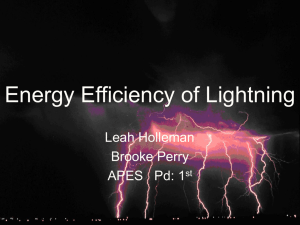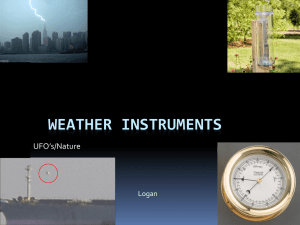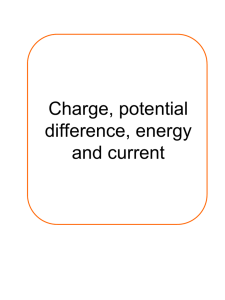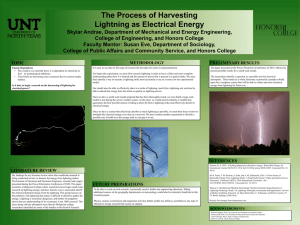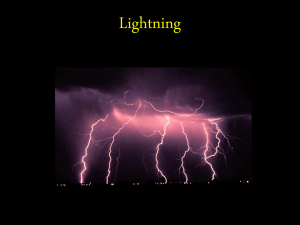Measurement of Voltages and Currents in Residential Household
advertisement
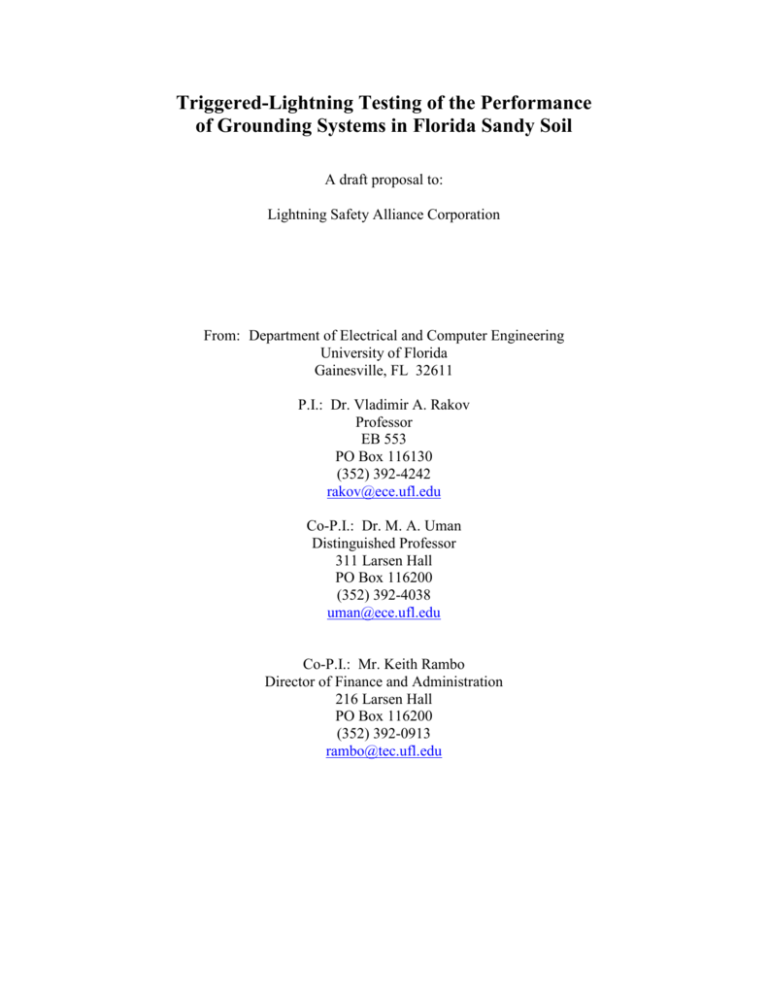
Triggered-Lightning Testing of the Performance of Grounding Systems in Florida Sandy Soil A draft proposal to: Lightning Safety Alliance Corporation From: Department of Electrical and Computer Engineering University of Florida Gainesville, FL 32611 P.I.: Dr. Vladimir A. Rakov Professor EB 553 PO Box 116130 (352) 392-4242 rakov@ece.ufl.edu Co-P.I.: Dr. M. A. Uman Distinguished Professor 311 Larsen Hall PO Box 116200 (352) 392-4038 uman@ece.ufl.edu Co-P.I.: Mr. Keith Rambo Director of Finance and Administration 216 Larsen Hall PO Box 116200 (352) 392-0913 rambo@tec.ufl.edu A. ABSTRACT The University of Florida (UF) proposes a two-year study to measure the currents occurring in the wiring and grounding of a specially-constructed residential structure when lightning, artificially initiated from natural thunderstorms using the rocket-and-wire technique, strikes the structure’s lightning protective system. The experiments will take place at the UF’s International Center for Lightning Research and Testing (ICLRT) at Camp Blanding, Florida. The test residential structure has recently been constructed at the ICLRT by a commercial builder with funding from the State of Florida’s Department of Community Affairs. It contains open interior walls that expose the house wiring for measurement access, incoming underground and overhead power, and incoming telephone (communication) lines. The lightning protective system will be installed by the Lightning Safety Alliance Corporation (LSA), according to current real-world lightning protection practices. The test plan envisions artificially-initiating (triggering) 2 to 3 lightning flashes per year for each of the two years of the study. During the first year, measurements will be made of the pertinent currents produced in the structure by lightning strikes to the structure equipped with a single 8 or 10 foot vertical ground rod. For the second year, the structure will be equipped with four vertical ground rods (one at each corner) interconnected by a buried horizontal conductor. A comparison of the performance of the two types of grounding systems under direct lightning strike conditions should allow us to formulate recommendations for optimizing lightning protection of structures. Note that in previous experiments at the ICLRT, vertical ground rods were found to be less efficient than assumed in lightning protection standards. The estimated cost of the proposed work is $40,000 per year. 2 B. PROJECT DESCRIPTION 1. Introduction The National Lightning Safety Institute (NLSI) (www.lightningsafety.com) has estimated that the total annual cost of lightning damage in the United States is near $5 billion. About 25 million cloud-to-ground lightning discharges strike the United States annually. Florida has a higher incidence of lightning than any other state. From 10 to 15 percent of all lightning deaths and injuries in the U. S. occur in Florida, and, by the best available estimates, about 10 percent of all other lightning-related losses, except for forest fire losses, occur in Florida. There are apparently near $1 billion dollars in annual homeowner insurance claims in the U.S. According to R. L. Holle, R. Lopez, L. J. Arnold, and L. Enders, Insured Lightning-Caused Property Damage in Three Western States, Journal of Applied Meteorology, Vol. 35, No. 8, pp. 13441351, August 1996, the average loss for personal and commercial lightning claims combined is $916 per claim. These lightning losses could be drastically reduced by the implementation of proper lightning protection techniques. 2. The ICLRT (www.lightning.ece.ufl.edu) The International Center for Lightning Research and Testing (ICLRT) is presently the only facility in the world where lightning is artificially initiated from natural thunderstorms on a regular basis for the purpose of studying its physics and effects. A photograph of triggered lightning at the ICLRT is shown in Fig. 1. In October 1994, the UF and the Florida Army National Guard/Armory Board signed an agreement forming the ICLRT. The ICLRT occupies about 1 km2 at the Camp Blanding Florida Army National Guard Base, about 45 km northeast of the UF campus. Airspace is controlled so that lightning initiation from natural overhead thunderclouds using the rocket-and-wire technique can be routinely performed and the resulting 35 to 40 “triggered” lightnings per year can be studied and used for testing various objects and systems, in addition to the study of nearby natural lightning. On site are a 2500 square-foot office building, two launch trailers, one launch tower, one mobile launcher, four small instrumentation buildings, two overhead test power lines, a test airport runway, a small “simulated” test house, a large “test” residential structure (involved in this proposal), and an underground test power system. Distributed over about 0.5 km2 at the ICLRT is an 8 station electric and magnetic field measuring system (plus optical and current measurements at 3 additional stations) to enable the remote characterization of both triggered and close naturallyoccurring lightning (e.g., Crawford et al. 2001; Rakov et al. 2003; Jerauld et al. 2003). Triggered lightning currents are routinely measured at the rocket launcher (e.g., UF/FPL 2002 Report; see reference 9 in Section C1 of this proposal). Diagnostic equipment available at the ICLRT are found in the Facilities Section (Section H). Fig. 1. A view of lightning triggered from a rocket launcher at ground level at the UF International Center for Lightning Research and Testing, at Camp Blanding, Florida. The bottom, straight 300 m is due to the exploded triggering wire trailing behind the rocket. Above the wire trace, the typical tortuous lightning geometry is present. A drawing of the general site configuration in July 2002 is shown in Fig. 2. A photograph of part of the site is found in Fig. 1. From 1995 to 2002, about 40 scientists and engineers (excluding UF faculty, students and staff) from 13 countries representing 4 continents have performed experiments at the ICLRT on various aspects of atmospheric electricity, lightning, and lightning protection. 4 Fig. 2. Overview of the ICLRT in Summer 2002 showing the location of the test residential structure. As noted above, a test residential structure (see Figs. 2, 3, 4), typical of Florida housing, has been recently constructed at the ICLRT with funding from the State of Florida Department of Community Affairs with the intent that the structure be used to develop, using triggered lightning, lightning protection standards that could potentially be included in Florida building codes, thus providing for the reduction of lightning damage and costs to the insurers and the insured. To date there has been scant scientific study of the performance of grounding systems based on experimental data. Expected distributions of current for the most severe case, that of direct lightning strike to the structure, are based entirely on model predictions that are badly in need of experimental validation. C. PRIOR PERTINENT RESEARCH AT THE ICLRT As described in Rakov et al. (2002; attached), using triggered lightning and the predecessor, the “sim(ulated) house”, to our newly-constructed test residential structure, UF researchers at the ICLRT have examined two hypothetical scenarios suggested by the International Electrotechnical Commission (IEC) for the lightning current distribution in the electrical circuit of a residential building equipped with a lightning protective system when this system receives a direct strike. In one of these scenarios, suggested by IEC Technical Committee 81 (TC 81) responsible for the lightning protection of structures, one-half of the total lightning current is assumed to flow in the ground rod of the lightning protective system, onequarter in the connected power supply system ground rod, and the remaining one-quarter is assumed to enter the electrical circuit of the building. The latter current (25% of the total current) is assumed to split equally between the surge protective devices installed at the service entrance (12.5% of the total current) and the secondary neutral (12.5% of the total current). The other scenario is found in the IEC standard IEC 61 312-1. According to this scenario one-half of the total lightning current is assumed to flow to earth via the building’s grounding system (including all interconnected ground rods of the building), and the other half is assumed to enter the electrical circuit of the building (in the absence of other metallic services, such as metal gas pipes, entering the building). Thus, in the two IEC scenarios, either 25% or 50% of the total lightning current is assumed to enter the building’s electrical circuit and to flow to the distribution transformer’s ground and to other grounds in the system. It is important to note that the IEC current distributions assume that the current waveshapes in all parts of the circuit are the same. In our study, we showed that, for triggered lightning striking our “sim house,” the current waveshapes in the two ground rods (one ground rod for the lightning protection system and one for the utility meter) of the sim house differ markedly from the current waveshapes in other parts of the test system. The grounding system of the sim house was subjected to triggered-lightning discharges for three different configurations, with the house’s electrical circuit (a utility meter followed by dummy resistive loads) being connected to the secondary of a pad-mounted transformer about 50 m distant. The primary of the transformer was connected to a 650-m underground cable which was open-circuited at the other end. The cable’s neutral was grounded at the transformer and at the open-circuited end. The two ground rods at the sim house appeared to filter out the higher frequency components of the lightning current, allowing the lower frequency components to enter the house’s electrical circuit. In other words, the ground rods exhibited a capacitive rather than the often expected and usually modeled resistive behavior. This effect was observed for dc resistances of the ground rods (in typical Florida sandy soil) ranging from more than a thousand ohms to some tens of ohms. The peak value of the current entering the sim house’s electrical circuit was found to be over 80% of the injected lightning current peak, in contrast with the 25% or 50% assumed in two IEC-suggested scenarios. Also, the percentages of current flowing a) to the transformer secondary neutral and b) through the surge protection devices (SPD) were observed to be approximately a factor of two to four greater than those assumed in one of the IEC hypothetical scenarios. Since the current waveshapes differed considerably throughout the system, we suggested in the paper that a better quantity than the peak current to use for studying the division of lightning current among the various paths in the system would be the charge transferred. These and other findings are included in the informative part of the IEEE Standard on low-voltage surge protective devices. In addition to the directly applicable sim house experience described above, we have also been studying the voltages and currents induced by direct and nearby triggered lightning strikes on Florida Power and Light overhead distribution power lines. This research is presently in its fifth year. We have also studied, for a two-year period, the interaction of lightning with a test airport runway lighting system. This project was funded by the Florida Department of Transportation. A representative sample of journal papers and reports describing these two studies is found below: 1. 2. 3. 6 “Measurement of the Division of Lightning Return Stroke Current among the Multiple Arresters and Grounds of a Power Distribution Line”, IEEE Trans. On Power Delivery, (2003), Vol. 18, No. 4, 1203-1208, C. T. Mata, V. A. Rakov, K. J. Rambo, P. Diaz, R. Rey, and M. A. Uman "Triggered Lightning Testing of an Airport Runway Lighting System", IEEE Trans. on EMC, in press, 2003, M. Bejleri, V.A. Rakov, M.A. Uman, K.J. Rambo, C.T. Mata, M.I. Fernandez "Direct Lightning Strikes to the Lightning Protective System of a Residential Building: Triggered-Lightning Experiments", IEEE Trans. on Power Delivery, 17(2), 575-586, 2002, 4. 5. 6. 7. 8. 9. 10. 11. 12. D. V.A. Rakov, M.A. Uman, M.I., Fernandez, C.T. Mata, K.T. Rambo, M.V. Stapleton, and R.R. Sutil. "Small Shelters and Safety from Lightning", Golf Course Management, 68, 104-112, 2000, R. Kithil and V. Rakov. "EMTP Modeling of a Triggered-Lightning Strike to the Phase Conductor of an Overhead Distribution Line", IEEE Trans. on Power Delivery, 15(4), 1175-1181, 2000, C.T. Mata, M.I. Fernandez, V.A. Rakov, and M.A. Uman. "Performance of MOV Arresters During Very Close, Direct Lightning Strikes to a Power Distribution System", IEEE Trans. on Power Delivery, vol. 14, No. 2, April 1999, pp. 411418, M.I. Fernandez, K.J. Rambo, V.A. Rakov, and M.A. Uman. "Triggered-Lightning Experiments at Camp Blanding, Florida (1993-1995)", Trans. of IEE Japan, Special Issue on Artificial Rocket Triggered Lightning, Vol. 117-B, No. 4, 446-452, 1997, M.A. Uman, V.A. Rakov, K.J. Rambo, T.W. Vaught, M.I. Fernandez, D.J. Cordier, R.M. Chandler,R. Bernstein, and C. Golden. "Review of Recent Lightning Research at the University of Florida", Elektrotechnik und Informationstechnik (Austria), 112, No.6, 262-265 (1995), V.A. Rakov, M.A. Uman, and R. Thottappillil. UF/FPL Study of Triggered Lightning Strikes to FPL Distribution Lines, A.G. Mata, C.T. Mata, V.A. Rakov, M.A. Uman, J.D. Schoene, K.J. Rambo, D.M. Jordan, J.E. Jason, Phase IV Report, University of Florida, 258 p., December 2002. UF/FPL Study of Triggered Lightning Strikes to FPL Distribution Lines: 2001 Experiments, A.G. Mata, V.A. Rakov, K.J. Rambo, M.V. Stapleton, and M.A. Uman, Phase III Report, University of Florida, 25 p., December 2001. UF/FPL Study of Triggered Lightning Strikes to FPL Distribution Lines: 2000 Experiments, C.T. Mata, V.A. Rakov, K.J. Rambo, and M.A. Uman, Final Report, University of Florida, 321 p., December 2000. M.A. Uman and V.A. Rakov, "A Critical Review of Nonconventional Approaches to Lightning Protection", Bull. Amer. Meteorol. Soc., December 2002, 1809-1820. THE PROPOSED EXPERIMENT Photographs of our new test residential structure are shown in Figs. 3 and 4. Fig. 3 is an external view showing the two Florida Power and Light test distribution lines in the background, about 40 m from the structure. Fig. 4 shows an internal view of the structure. The figure captions contain detailed information regarding the scenes in the photographs. Fig. 3. The test residential structure at the International Center for Lightning Research and Testing in a view looking south. Underground power service to the structure is evident on the north face of the structure. Two Florida Power and Light test distribution lines are located south of the structure. Fig. 4. An interior view of the test residential structure. The back wall (the north wall) has the circuit breaker box mounted on it. Open wall wiring is evident throughout the structure. In the foreground is a bathtub, sink, and toilet with appropriate plumbing. 8 The proposed test plan is given below. Triggered lightning currents are to be measured at the rocket launcher using our usual techniques (e.g., UF/FPL report, 2002; see reference 9 in Section C of this proposal): 1. First year: (a) Structural lightning protection with a single 8 or 10 foot vertical ground rod on the test house to be installed by LSA. (b) Implement instrumentation on the house’s ground rod, incoming services, and representative circuits inside the structure, for current measurements, to be transmitted by fiber optic links from the test house to the launch control trailer where they will be digitized and stored. The electrical circuit of the test house will be connected to a 50-m low-voltage underground cable whose neutral will be grounded at the other end. (c) Trigger 2 to 3 lightning flashes to the lightning protective system of the test house. (d) Analyze data obtained. The experimental set-up for the first year will be similar to that described by Rakov et al. (2002; attached), except for the following two aspects. (1) The same type of current measuring device will be used in different parts of the electrical circuit in order to assure that the observed differences in current waveforms are not influenced by instrumentation. (2) There will be no transformer connected to the low-voltage service cable in order to make the test configuration more suitable for modeling, which should allow us to extrapolate our results to other configurations. 2. Second year: Same as the First year, but three more 8 or 10 foot vertical ground rods are installed, so that there is one ground rod at each corner, and all ground rods are interconnected by a horizontal 17 AWG copper conductor buried at a depth of 2 1/2 ft, as per NFPA 780. E. ANALYSIS AND REPORTING PLAN Data will be taken primarily during the summers of the proposed two-year program, since overhead thunderstorms are necessary to implement the lightning-triggering process. Analysis will be on-going during the two years. One graduate student (part-time) will be assigned to the project, as well as one engineer (part-time) and two UF faculty members (part-time). A technical report for the LSA will be prepared at the end of the second year. Research material from our lightning studies forms an important part of the popular UF senior-first-year-graduate electrical engineering course “Lightning” taught by PI Dr. Vladimir Rakov and, this year, shown statewide for graduate course credit on the UF television network. Additionally, lightning related material is included in three undergraduate and two graduate electrical engineering courses in the electromagnetics area. Dr. Rakov has given invited talks about lightning and lightning protection, including personal safety, worldwide (ten invited talks in 2002-2003). F. Biographical Sketches VLADIMIR A. RAKOV Department of Electrical and Computer Engineering University of Florida Gainesville, FL 32611-6130 Phone: (352) 392-4242, FAX: (352) 392-8671 E-mail: rakov@.ece.ufl.edu., web site: http://plaza.ufl.edu/rakov/ A. Professional Preparation: Tomsk Polytechnic, Russia Tomsk Polytechnic, Russia EE EE Ph.D. (Lightning Area) M.S. (High Honors) 1983 1977 B. Appointments: 08/98 – present 06/91 - 08/98 10/79 - 06/94 09/77 – 10/79 Professor, Department of Electrical and Computer Engineering, University of Florida, Gainesville Associate Professor, Department of Electrical and Computer Engineering, University of Florida, Gainesville Director of Lightning Research Laboratory (02/84 – 06/94), Senior Researcher (02/83 – 02/84), Researcher (10/79 - 02/83), Tomsk Polytechnic, Russia Assistant Professor, Department of Electrical Engineering, Tomsk Polytechnic, Russia C. Selected Publications, all closely related to the proposed projects: (from a total of over 300 including monograph "Lightning: Physics and Effects", Cambridge University Press, 687 p., 2003) 1. Rakov, V.A., Crawford, D., Kodali, V., Idone, V.P., Uman, M.A., Schnetzer, G.H., and Rambo, K.J. Cutoff and Re-Establishment of Current in Rocket-Triggered Lightning, J. Geophys. Res., submitted, 2003. 2. Rakov, V.A. A Review of Positive and Bipolar Lightning Discharges", Bull. Amer. Meteorol. Soc., June 2003, pp. 767-776. 3. Rakov, V.A. "Lightning Discharges Triggered Using Rocket-and-Wire Techniques", Recent Res. Devel. Geophysics, 2, 141-171, 1999. 4. Wang, D., Rakov, V.A., Uman, M.A., Takagi, N., Watanabe, T., Crawford, D., Rambo, K.J., Schnetzer, G.H., Fisher, R.J., and Kawasaki, Z.-I. "Attachment Process in Rocket-Triggered Lightning Strokes", J. Geophys. Res., 104,2141-2150, 1999a. 5. Rakov, V.A., Uman, M.A., Rambo, K.J., Fernandez, M.I., Fisher, R.J., Schnetzer, G.H., Thottappillil, R., Eybert-Berard, A., Berlandis, J.P., Lalande, P., Bonamy, A., Laroche, P. and Bondiou-Clergerie, A. "New Insights into Lightning Processes Gained from Triggered-Lightning Experiments in Florida and Alabama", J. Geophys. Res., 103, 14,117-14,130, 1998. 6. Rakov, V.A., and Uman, M.A. "Review and Evaluation of Lightning Return Stroke Models Including Some Aspects of Their Application", IEEE Trans. on EMC, vol. 40, No.4, part II, Special Issue on Lightning, pp. 403426, November, 1998. 7. Diendorfer, G., Schulz, W., and Rakov, V.A. "Lightning Characteristics Based on Data from the Austrian Lightning Locating System", IEEE Trans. on EMC, vol. 40, No.4, part II, Special Issue on Lightning, pp. 452464, November, 1998. 8. Rakov, V.A. "Some Inferences on the Propagation Mechanisms of Dart Leaders and Return Strokes", J. Geophys. Res., 103, 1879-1887, 1998. 9. Thottappillil, R., Rakov, V.A., and Uman, M.A. "Distribution of Charge Along the Lightning Channel: Relation to Remote Electric and Magnetic Fields and to Return-Stroke Models", J. Geophys. Res., 102, 6987-7006, 1997. 10. Rakov, V.A., Thottappillil, R., Uman, M.A., and Barker, P.P. "Mechanism of the Lightning M Component", J. Geophys. Res., 100, 25,701-25,710,1995. D. Synergistic Activities: 10 Preparation of text and course packet for the senior/graduate course EEL 5490, Lightning (also available via UF Distance Learning Program); mentoring undergraduate students (2 during the last year) from underrepresented groups; two awards for service to High School Student Science programs; faculty advisor for the AMS Student Chapter at UF. Organizing and/or chairing lightning sessions at international conferences, including International Conference on Atmospheric Electricity, International Conference on Lightning Protection, AGU Fall Meeting, International Conference on Lightning and Static Electricity, and International Zurich Symposium on EMC (a total of 12 during the last 5 years). Giving invited lectures on various aspects of lightning worldwide (10 during 2002-2003); work published in English, Russian, Japanese, German, Portuguese, Polish, and Ukrainian; bridging the areas of atmospheric electricity, lightning physics, and lightning protection; popularization of lightning and lightning safety in mass media (radio, television, newspapers). Reviewer for leading AMS, AGU, and IEEE journals, publishers, and agencies (2-3 reviews per month). Fellow of two professional societies, IEEE and AMS. Committee Chairmanships and Memberships (partial list): AGU Committee on Atmospheric and Space Electricity (CASE), Chair, 2000-2002; Member, 1996-2000 International Commission on Atmospheric Electricity, Member, 1999-2007 Technical Program Committee on Lightning for the biennial International Zurich Symposium on Electromagnetic Compatibility, Chairman, 1997-present Steering Committee for the International Symposium on Lightning Protection (SIPDA), Member, 1998-present Fall AGU Meeting Program Committee, Member, 2001 AMS Science and Technology Committee on Atmospheric Electricity, Member, 2001-2004 Scientific Committee for the International Conference on Lightning Protection, Member, 2000-present Board of Advisors of the National Lightning Safety Institute, Member, 2002-present International Advisory Committee for the PowerTech Conference, Member, 2002-present UL Standards Technical Panel for Lightning Protection Components, Member, 2001-present Editor’s Choice - Atmospheric Electricity (AGU Electronic Journal), Advisory Panel Member, 2001-present Program Committee for the International Conference on Nonlinear Phenomena in Environmental Research, Member, 2003 E. Collaborators and Other Affiliations Collaborators within the last 48 months: V. Cooray and R. Thottappillil (University of Uppsala, Sweden), G. Diendorfer (ALDIS, Austria), J. Dwyer (FIT, Florida), F. Heidler and W. Zischank (University of Armed Forces, Munich, Germany), G. Huffines (AFIT, Ohio), V.P.Idone, (SUNYA), Z.I. Kawasaki (Osaka University, Japan), P. Laroche, P. Lalande, A. Bondiou-Clergerie (ONERA, France), F. Rachidi (EPFL, Switzerland), M. Miki (CRIEPI, Japan), R. Moini (Teheran Technical University, Iran), C.A. Nucci, (University of Bologna, Italy), D. Wang, (Gifu University, Japan). Graduate Advisors: Dr. Alfred A. Dulzon (Ph.D.) and Dr. Rostislav I. Borisov (M.S.), Tomsk Polytechnic, Russia Graduate Students Advised Over Past 5 Years: D.E. Crawford (M.S.), M.I. Fernandez (M.S.), M. Bejleri (M.S.), C. Mata (Ph.D.), R. Sutil (M.S.), S.M. Davis (Ph.D.), J. Schoene (M.S. and Ph.D.), J. Jerauld (M.S. and Ph.D.), V. Kodali (M.S.), R. Olsen (M.S.), B. Tabrez (M.S.), A. Mata (M.S.), V. Jayakumar (M.S.). Visiting Scholars: D. Wang (Japan), K. Okano (Japan), K. Chrzan (Poland), M. Miki (Japan), N. Solorzano (Brazil), E. Petrache (Switzerland), M. Paolone (Italy), Y. Baba (Japan). Total Advised: 38 M.S., 17 Ph.D., 7 postdocs. MARTIN A. UMAN Department of Electrical and Computer Engineering University of Florida, Gainesville, FL 32611 Telephone: (352) 392_0913 FAX: (352j392-8671 email: uman@ece.ufl.edu A. Education Princeton University Princeton University Princeton University Electrical Engineering Electrical Engineering Electrical Engineering BSE MA Ph.D. 1957 1959 1961 B. Appointments 2003-present 1991- 2003 1971-2003 1865- 1971 1961 -1965 Summer, 1958 Summer, 1958 Summer, 1957 Summer, 1956 Distinguished Professor, Department of Electrical and Computer Engineering, University of Florida, Gainesville, FL Professor and Chair, Department of Electrical and Computer Engineering, University of Florida, Gainesville, FL Professor, Department of Electrical Engineering, University of Florida, Gainesville, FL Fellow Physicist, Westinghouse Research Labs, Pittsburgh, PA Associate Professor of Electrical Engineering, University of Arizona, Tucson, AZ Scientist, Elcon Laboratory, Inc., Cambridge, MA Research Assistant, Forrestal Research Center, Princeton, NJ Research Associate, Sperry Gyroscope Company, Great Neck, NY Research Assistant, Sandia Corporation; Albuquerque, NM C. Publications (from over 160 total refereed publications): 1. “Statistical Characteristics of the Electric and Magnetic Fields and Their Time Derivatives 15 m and 30 m from Triggered Lightning”, J. Geophys, Res, 108(D6), 4192, J. Schoene, M.A. Uman, V.A. Rakov, V. Kodali, K.J. Rambo, G.H. Schnetzer. 2. “The Interaction of Lightning with Airborne Vehicles,” Progress in Aerospace Sciences, 39, 61-81, 2003, M.A. Uman and V.A. Rakov. 3. “Energetic Radiation Produced by Rocket-Triggered Lightning”, Science, January 2003, Vol. 299, 694-697, J.R. Dwyer, M.A. Uman, H.K. Rassoul, M. Al-Dayeh, E.L. Caraway, J. Jerauld, V.A. Rakov, D.M. Jordan, K.J. Rambo, V. Corbin, and B. Wright. 4. “A Critical Review of Non-Conventional Approaches to Lightning Protection”, Bull. Amer. Meteorol. Soc., 83, 1809-1820, (2002) M.A. Uman and V.A. Rakov. 5. ACorrelated Time Derivatives of Current, Electric Field Intensity, and Magnetic Flux Density for Triggered Lightning at 15 m,@ J. Geophys. Res., Vol. 107, No. D13, 10.1029/2000JD000249 (2002), M. A. Uman, J. Schoene, V.A. Rakov, K.J. Rambo, and G.H. Schnetzer. 6. "Time Derivative of the Electric Field 10, 14, and 30 m From Triggered Lightning Strokes," J. Geophys. Res., 105, 15,577-15,595, (2000), M.A. Uman, V.A. Rakov, G.H. Schnetzer, K.J. Rambo, D.E. Crawford, and R.J. Fisher. 7. "Observed Leader and Return-Stroke Propagation Characteristics in the Bottom 400 m of the Rocket Triggered Lightning Channel," J. Geophys. Res., 1Q.1, 14,369-14,376, (1999), D. Wang, N. Takagi, T. Watanabe, V.A. Rakov, and M.A. Uman. 8. M.A. Uman, "The Lightning Discharge," Academic Press, San Diego, 377 p., 1987; Dover Publications, Revised Edition, 2001. 9. M. Rubinstein, F. Rachidi, M.A. Uman, R. Thottappiliil, V.A. Rakov, C.A. Nucci, "Characterization of Ground Level Vertical Electric Fields 500 m and 30 m from Triggered Lightning," J. Geophys. Res., 100, 8863-8872, 1995. 10. R. Thottappillil and M.A. Uman, "Comparison of Return-Stroke Models," J. Geophys. Res., 98, 22,903-22,914, 1993. 12 Synergistic Activities: Awards: 2001 American Geophysical Union John Adam Fleming Medal for original research and technical leadership in geomagnetism, atmospheric, electricity, space science, aeronomy, and related sciences. Citation: for outstanding contribution to the description and understanding of electricity and magnetism of the earth and its atmosphere. 1996 IEEE Heinrich Hertz Medal. Citation: for outstanding contributions to the understanding of lightning electromagnetics and its application to lightning detection and protection. Professional Activity: Reviewer for various technical journals (J. Geophys. Res, IEEE Trans. Power Delivery, IEEE Trans. on EMC, Science) - about 10 per year. Invited speaker at various international and national conferences and workshops. Various interviews given relating to current lightning research and lightning safety to magazines, radio, and TV. Committee Memberships: IEEE Heinrich Hertz Medal Committee, 1999-2000 American Geophysical Union, Atmospheric Sciences Section EJ Committee, 1995-1999 American Geophysical Union Fellow/Awards Committee, Atmospheric Sciences Section, 1993-1999, Chairman, 1996-1999 International Conference on Lightning Protection: Scientific Conference committee-20th ICLP, Interlaken, Switzerland, 1990; 2 1992; 22nd ICLP, Budapest. 1994; 23rd ICLP, Florence, Italy, 1996 CIGRE Working Group 33.11, Task Force on Lightning, 1990- Present IEEE Working Group on Lightning Performance of Distribution Lines, 1979-present IEEE Working Group on Estimating ofPerforma11ce of Transmission Lines, 1985-present Collaborators and Other Affiliations (other than those cited in the publication list): Collaborators: W. H. Beasley (University of Oklahoma), R. Fisher (Sandia Natl Labs), Vincent Idone (SUNY A), D. Jordan (University of West Florida), E.P. Krider (University of Arizona), C. Mazzetti (University of Rome "La Sapienza"), M. Miki (CRIEPI, Japan), C.A. Nucci (University of Bologna, Italy), G. Schnetzer, (Private Consultant), (N. Takagi (Gifu University, Japan), D. Wang (Gifu University, Japan), T. Watanabe (Gifu University, Japan). Graduate and Post Doctoral Advisor: Dr. George Warfield, Master and Pill, Princeton University Thesis Advisor and Postgraduate-Scholar Sponsor: J. Jerauld (M.S.), R. Thottappillil (Ph.D.), Y. Villanueva (M.S.), J.A. Versaggi (M.S.), Y. Su (M.S.), J.A. Bach (M.S.), D.E. Crawford (M.S.), M.I. Fernandez (M.S.), M. Bejleri (M.S.), C. Mata (Ph.D.), J. Schoene (M.S.). Total advised: 6 Ph.D. students, 26 M.S. students. KEITH J. RAMBO DEPARTMENT OF ELECTRICAL AND COMPUTER ENGINEERING UNIVERSITY OF FLORIDA GAINESVILLE, FLORIDA 32611-6120 Phone: (352) 392-4243 E-mail: rambo@ufl.edu A. PROFESSIONAL PREPARATION: BS B. Electrical Engineering 1978 University of Florida APPOINTMENTS: 1989-Present: Associate in Engineering, Department of Electrical and Computer Engineering, University of Florida, Gainesville, Florida 1986: Assistant in Engineering, Department of Electrical Engineering, University of Florida, Gainesville, Florida 1985-1986: President, Crop Data Inc., Gainesville, Florida 1983-1985: Product Line Manager, Xicor Inc., Milpitas, California 1983: Engineering Manager, Xicor Inc., Milpitas California 1979-1983: Senior Process Engineer, Intel Corp., Santa Clara, California 1979: Process Engineer, Intel Corp., Santa Clara, California 1974-1978: Research Assistant, Department of Electrical Engineering, University of Florida, Gainesville, Florida C. 1. 2. 3. 4. 5. 6. 7. 14 PUBLICATIONS “Statistical Characteristics of the Electric and Magnetic Fields and Their Time Derivatives 15 m and 30 m from Triggered Lightning”, J. Geophys, Res, 108(D6), 4192, J. Schoene, M.A. Uman, V.A. Rakov, V. Kodali, K.J. Rambo, G.H. Schnetzer. "Triggered Lightning Testing of an Airport Runway Lighting System", IEEE Trans. on EMC, M. Bejleri, V.A. Rakov, M.A. Uman, K.J. Rambo, C.T. Mata, M.I. Fernandez, accepted 2003. “Energetic Radiation Produced by Rocket-Triggered Lightning”, Science, January 2003, Vol. 299, 694-697, J.R. Dwyer, M.A. Uman, H.K. Rassoul, M. Al-Dayeh, E.L. Caraway, J. Jerauld, V.A. Rakov, D.M. Jordan, K.J. Rambo, V. Corbin, and B. Wright. ACorrelated Time Derivatives of Current, Electric Field Intensity, and Magnetic Flux Density for Triggered Lightning at 15 m,@ J. Geophys. Res., Vol. 107, No. D13, 10.1029/2000JD000249 (2002), M. A. Uman, J. Schoene, V.A. Rakov, K.J. Rambo, and G.H. Schnetzer. "Time Derivative of the Electric Field 10, 14, and 30 m From Triggered Lightning Strokes," J. Geophys. Res., 105, 15,577-15,595, (2000), M.A. Uman, V.A. Rakov, G.H. Schnetzer, K.J. Rambo, D.E. Crawford, and R.J. Fisher. "Electric Fields Near Triggered Lightning Channels Measured with Pockels Sensors", J. Geophys. Res., 107, No. D16, 10.1029/2001JD001087 (2002), M. Miki, V.A. Rakov, K.J. Rambo, G.H. Schnetzer, and M.A. Uman. AClose Lightning Electromagnetic Environment for Aircraft Testing,@ SAE 2001 Transactions, Vol. 110, Journal of Aerospace, Section 1, M.A. Uman, V.A. Rakov, J. Schoene, K.J. Rambo, J. Jerauld, and G.H. Schnetzer. 8. 9. 10. D. AM-Component Mode of Charge Transfer to Ground in Lightning Discharges@, J. Geophys. Res., 106, 22,817-22,831, (2001), V.A. Rakov, D.E. Crawford, K.J. Rambo, G.H. Schnetzer, M.A. Uman, R. Thottappillil. AThe Close Lightning Electromagnetic Environment: Dart-leader Electric Field Change versus Distance,@ J. Geophys. Res., 106, 14,909-14,917, (2001), D.E. Crawford, V.A. Rakov, M.A. Uman, G.H. Schnetzer, K.J. Rambo, and M.V. Stapleton. ACharacterization of the Initial Stage of Negative Rocket-Triggered Lightning,@ J. Geophys. Res., 104, 42134222 (1999), D. Wang, V.A. Rakov, M.A. Uman, M.I. Fernandez, K.J. Rambo, G.H. Schnetzer, and R.J. Fisher. SYNERGISTIC ACTIVITIES: College of Engineering Safety and Security Committee, Chair ECE Computer Coordination and Advisory Committee, Member G. REFERENCES 1. AThe Close Lightning Electromagnetic Environment: Dart-leader Electric Field Change versus Distance,@ J. Geophys. Res., 106, 14,909-14,917, (2001), D.E. Crawford, V.A. Rakov, M.A. Uman, G.H. Schnetzer, K.J. Rambo, and M.V. Stapleton. 2. "Triggered Lightning Testing of an Airport Runway Lighting System", IEEE Trans. on EMC, M. Bejleri, V.A. Rakov, M.A. Uman, K.J. Rambo, C.T. Mata, M.I. Fernandez, accepted 2003. 3. ADirect Lightning Strikes to the Lightning Protective System of a Residential Building: Triggered-Lightning Experiments,@ IEEE Trans. Power Delivery, 17(2), 575-586, 2002, V.A. Rakov, M.A. Uman, M.I. Fernandez, C.T. Mata, K.J. Rambo, M.V. Stapleton, and R.R. Sutil. 4. UF/FPL Study of Triggered Lightning Strikes to FPL Distribution Lines, A.G. Mata, C.T. Mata, V.A. Rakov, M.A. Uman, J.D. Schoene, K.J. Rambo, D.M. Jordan, J.E. Jason, Phase IV Report, University of Florida, 258 p., December 2002. 5. "Multiple-Station Measurements of Electric and Magnetic Fields Due to Natural Lightning", in Proc. Int. Conf. on Lightning and Static Electricity, United Kingdom, 2003, J. Jerauld, V.A. Rakov, M.A. Uman, D.E. Crawford, B.A. DeCarlo, D.M. Jordan, K.J. Rambo, and G.H. Schnetzer 16 H. FACILITIES On the 1 km x 1 km research site at the Camp Blanding Army National Guard Base are a 2500 square-foot office building, two launch trailers, one launch tower, one mobile launcher, four small instrumentation buildings, two overhead test power lines, a test airport runway, a small “simulated” test house, a large “test” residential structure (involved in this proposal), and an underground test power system. Distributed over the ICLRT is an 8 station electric and magnetic field measuring system to enable the remote characterization of both triggered and close naturally-occurring lightning (e.g., Crawford et al. 2001; Rakov et al. 2003). Diagnostic equipment available at the ICLRT includes: Oscilloscopes: 1 LeCroy Wave Runner 4 channel 500 MHz 8 bit 4Mb/channel systems 7 LeCroy Wave Runner 4 channel 500 MHz 8 bit 1Mb/channel systems 1 LeCroy 9854 4 channel 500 MHz 8 bit 0.5Mb/channel system 5 LeCroy 9400 2 channel 500 MHz 8 bit 64 Kb/channel systems 5 Nicolet Pro 90 4 channel 8/12 bit 200/10 MHz 8/12 bit 256 Kb/channel systems 1 Nicolet Multipro 16 channel 10 MHz 12 bit 1 Mb/channel system High-Speed Instrumentation Recorders: 1 Ampex 14 channel FM DC-500 MHz 1 Honeywell 14 Channel, seven FM DC-500 MHz, seven 100 Hz – 2 MHz Direct Fiber Optics: 13 Optocomm DC to 30 MHz TX/RX systems, 500 meter length 48 Isobe 3000 DC to 15 MHz TX/RX systems, 500 meter length 12 Meret .05 Hz to 20 MHz TX/RX systems, 500 meter length 16 Dymec DC to 1 MHz TX/RX systems, 100 meter length Sensors: 15 5 kJ current viewing resistors, nine 8 MHz, four 12 MHz, and two 48 MHz units 12 Pearson 110 A, six clamp-on, six std, wideband current transformers 8 Pearson 3025, six clamp-on, two std, wideband current transformers 17 Flat Plate electric field antennas 10 magnetic field antennas 6 magnetic field derivative antenna integrating electronics 2 Mission Instrument electric field mills 8 NASA field mills 1 EG&G current derivative sensor Optical: 5 SVHS cameras and recorders 3 Hi-8 cameras and recorders 3 Digital cameras and recorders 6 35 mm still cameras 1 4 ms 16 mm framing camera 2 high-speed streak cameras 1 BIFO Image Converter Camera



